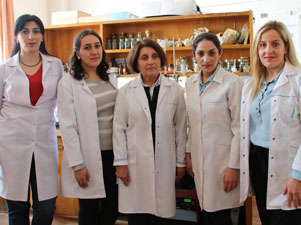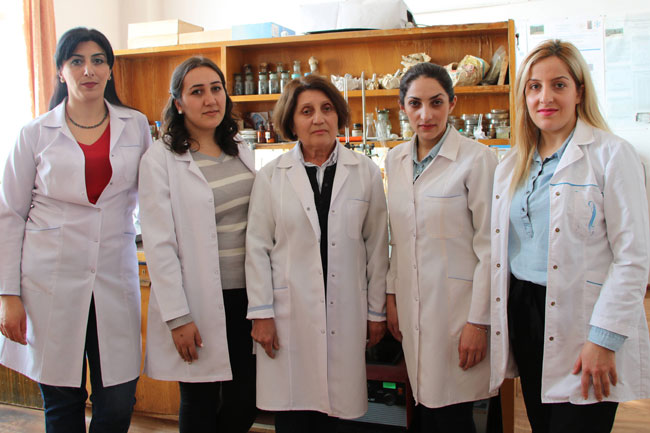| ||||||||
At the SPC "Armbiotechnology" of NAS RA, the possibilities of microbiological bioleaching of low-grade porphyry copper (0.63-0.77%) ore of the Kajaran copper-molybdenum mine and the efficiency of the copper bioextraction process have been studied. The research was carried out within the framework of the topic "Obtaining, study and application of bacterial consortia in the effective processes of copper and other precious metals bioextraction from primary and secondary raw materials" under the supervision of Narine Vardanyan, the Head of the Laboratory of Metal Bioleaching, Doctor of Biological Sciences. "Along with the depletion of rich copper world resources, the interest in poor ores with low copper content (0.2-2.0%) is growing. Microbiological bioleaching is beneficial for the mentioned ores and safe for the environment. This method is the most promising for poor ores, ore-tailings, the processing of which is not profitable while using the traditional pyrometallurgical method and poses a great danger to the environment," said Narine Vardanyan. The modern highly efficient, environmentally friendly method of bioleaching for metal extraction has not been used in Armenia yet. In this purpose, research has been carried out to study the diversity of metals degrading bacteria, their dissemination in the biotopes of copper ores in Armenia and Artsakh. "Metals degrading bacteria have been isolated from Kajaran ores in Armenia and Kashen ores in Artsakh. The physiological properties of the isolated bacteria, their resistance to heavy metals, and their ability to degrade sulfide minerals have been studied. The influence of physicochemical and technological factors on the process of bioextraction of copper by isolated bacteria and their communities has been studied as well.
The results of the mineralogical studies of bioleaching residues have revealed the mechanism of ore degradation. "Based on the data obtained, the scientific basis of the bioleaching process from Kajaran ore has been developed, a rich collection of metal degrading bacteria and a database have been created, allowing to develop effective, stable bacterial communities on the base of the most efficient strains for the processing of exact specific mineral ores," said Narine Vardanyan. The scientific work was carried out within the framework of the basic funding of the Center. The results were published in two book chapters (9, 10) published by Springer and in 8 scientific articles published in peer-reviewed journals listed in the Web of Science database. The research was highly evaluated by the RA Science Committee. Narine Vardanyan and Arevik Vardanyan, a Senior Researcher, Candidate of Biological Sciences, were recognized in 2021 as highly efficient researchers involved in scientific topics. The scientific research aroused great interest among German colleagues. At their invitation, Narine Vardanyan and Anna Khachatryan, a Researcher of the Center, were sent on a business trip to the Martin-Luther University of Halle-Wittenberg in Germany in 2021. For two months, studies on bioleaching of copper ore were carried out in the Department of Biotechnology of the Faculty of Natural Sciences of the University, at the Institute of Microbiology, and at the Institute of Geology, jointly with Dr. Sabine Wilcher. The possibilities of further cooperation between the University of Halle-Wittenberg and the Laboratory of Metal Bioleaching of the Center were discussed with the German partners. At the initiative of the Chinese side, a program on the exchange of scientific results and joint research was approved in 2021 between the Institute of Oceanography of the Chinese Academy of Sciences and the SPC "Armbiotechnology" of NAS RA, titled "Study of the processes of bioleaching of non-ferrous metals from metallurgical slags and regeneration of biosolutions through the microorganisms, their communities and immobilized forms". |
General Page - About Academy - Divisions - Organizations - Members - Contact us - Structure - Presidium Members
Documents - Innovation Proposals - Publications - Funds - Conferences - Competitions - International cooperation
Youth programs - Photogallery - Videogallery - Web Resources Other Academies - "Gitutyun" newspaper - "In the World of Science" Journal
Publications in Press - Notices - Anniversaries - Universities - News - Scientific Results - Scientists of the Diaspora
Young Scientist Tribune - Our Honored Figures - Announcements - Sitemap - Search

